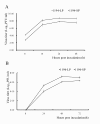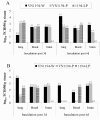Virulence of H5N1 virus in mice attenuates after in vitro serial passages
- PMID: 21371335
- PMCID: PMC3060145
- DOI: 10.1186/1743-422X-8-93
Virulence of H5N1 virus in mice attenuates after in vitro serial passages
Abstract
The virulence of A/Vietnam/1194/2004 (VN1194) in mice attenuated after serial passages in MDCK cells and chicken embryos, because the enriched large-plaque variants of the virus had significantly reduced virulence. In contrast, the small-plaque variants of the virus and the variants isolated from the brain of mice that were infected with the parental virus VN1194 had much higher virulence in mice. The virulence attenuation of serially propagated virus may be caused by the reduced neurotropism in mice. Our whole genome sequence analysis revealed substitutions of a total of two amino acids in PB1, three in PB2, two in PA common for virulence attenuated variants, all or part of which may be correlated with the virulence attenuation and reduced neurotropism of the serially propagated VN1194 in mice. Our study indicates that serial passages of VN1194 in vitro lead to adaptation and selection of variants that have markedly decreased virulence and neurotropism, which emphasizes the importance of direct analysis of original or less propagated virus samples.
Figures




Similar articles
-
PB1-mediated virulence attenuation of H5N1 influenza virus in mice is associated with PB2.J Gen Virol. 2011 Jun;92(Pt 6):1435-1444. doi: 10.1099/vir.0.030718-0. Epub 2011 Mar 2. J Gen Virol. 2011. PMID: 21367983
-
Single mutation at the amino acid position 627 of PB2 that leads to increased virulence of an H5N1 avian influenza virus during adaptation in mice can be compensated by multiple mutations at other sites of PB2.Virus Res. 2009 Sep;144(1-2):123-9. doi: 10.1016/j.virusres.2009.04.008. Epub 2009 Apr 23. Virus Res. 2009. PMID: 19393699
-
Characterization of low virulent strains of highly pathogenic A/Hong Kong/156/97 (H5N1) virus in mice after passage in embryonated hens' eggs.Virology. 2000 Jul 5;272(2):429-37. doi: 10.1006/viro.2000.0371. Virology. 2000. PMID: 10873787
-
Recent H5N1 avian influenza A virus increases rapidly in virulence to mice after a single passage in mice.J Gen Virol. 2006 Dec;87(Pt 12):3655-3659. doi: 10.1099/vir.0.81843-0. J Gen Virol. 2006. PMID: 17098982
-
An overview of the highly pathogenic H5N1 influenza virus.Virol Sin. 2013 Feb;28(1):3-15. doi: 10.1007/s12250-013-3294-9. Epub 2013 Jan 16. Virol Sin. 2013. PMID: 23325419 Free PMC article. Review.
Cited by
-
Discovery of New Ginsenol-Like Compounds with High Antiviral Activity.Molecules. 2021 Nov 10;26(22):6794. doi: 10.3390/molecules26226794. Molecules. 2021. PMID: 34833886 Free PMC article.
-
U4 at the 3' UTR of PB1 segment of H5N1 influenza virus promotes RNA polymerase activity and contributes to viral pathogenicity.PLoS One. 2014 Mar 27;9(3):e93366. doi: 10.1371/journal.pone.0093366. eCollection 2014. PLoS One. 2014. PMID: 24676059 Free PMC article.
-
Genomic representation predicts an asymptotic host adaptation of bat coronaviruses using deep learning.Front Microbiol. 2023 May 5;14:1157608. doi: 10.3389/fmicb.2023.1157608. eCollection 2023. Front Microbiol. 2023. PMID: 37213516 Free PMC article.
-
Highly pathogenic avian influenza virus subtype H5N1 escaping neutralization: more than HA variation.J Virol. 2012 Feb;86(3):1394-404. doi: 10.1128/JVI.00797-11. Epub 2011 Nov 16. J Virol. 2012. PMID: 22090121 Free PMC article.
-
Risk Assessment of the Possible Intermediate Host Role of Pigs for Coronaviruses with a Deep Learning Predictor.Viruses. 2023 Jul 15;15(7):1556. doi: 10.3390/v15071556. Viruses. 2023. PMID: 37515242 Free PMC article.
References
Publication types
MeSH terms
Substances
LinkOut - more resources
Full Text Sources
Medical
Miscellaneous

